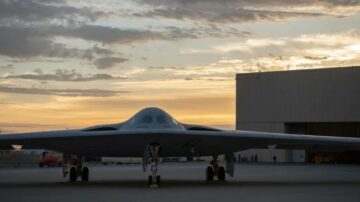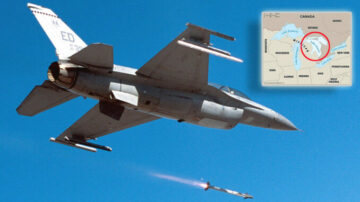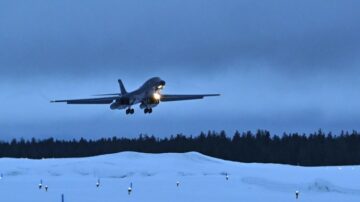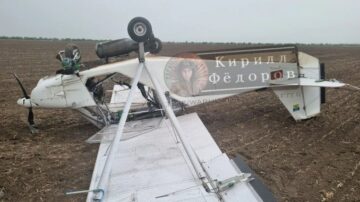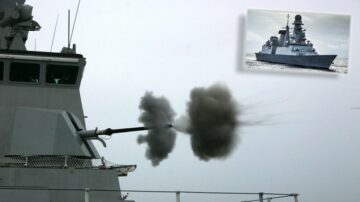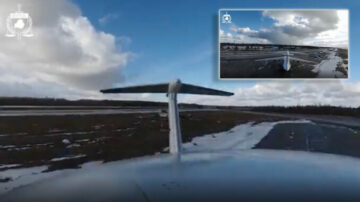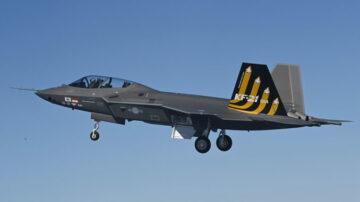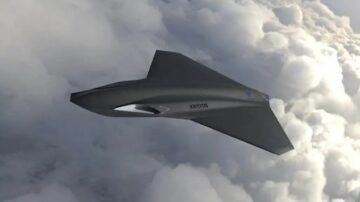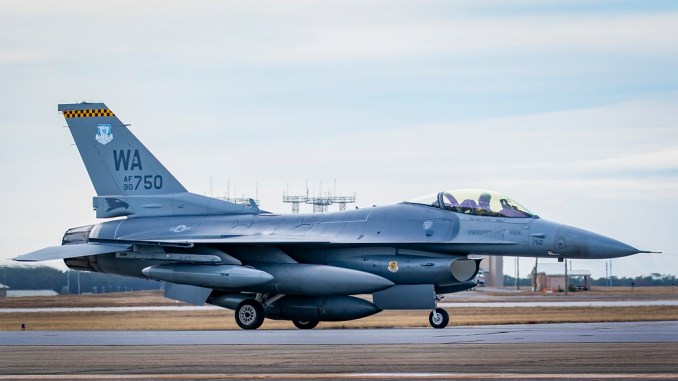
The service’s top civilian leader will board the back seat of the Viper later this spring and experience firsthand how the autonomous technology works.
U.S. Air Force Secretary Frank Kendall said, during a recent senate hearing on the service’s 2025 budget, that he will fly in one of the F-16s that are being used to test autonomous technology. The flight will reportedly take place later this spring and will allow the service top civilian leader to experience firsthand how the new technology performs in the air.
“I’m going to get a ride in an autonomously flown F-16 later this year,” said Kendall when asked about Collaborative Combat Aircraft by the Senate Appropriations Committee’s defense panel. “There will be a pilot with me who will just be watching, as I will be, as the autonomous technology works. Hopefully neither he or I will be needed to fly the airplane.”
The 2025 budget plans about $ 577 million for the Collaborative Combat Aircraft program, an increase of $170 million over 2024, and a total of $ 8.9 billion are planned in the 2025-2029 timeframe. CCAs are planned to be operational as early as 2028 with the first increment whose contracts are about to be awarded.
The Collaborative Combat Aircraft
The CCA programs aims to develop autonomous unmanned aircraft that will cooperate in the “loyal wingman” role with fifth- and sixth-generation combat aircraft as part of manned-unmanned teaming concepts. As already reported, the U.S. Air Force wants to procure 200 NGAD fighters along with 1,000 CCA that will cooperate in the “loyal wingman” role with the sixth-generation combat aircraft.
The Air Force is still defining the right balance in terms of requirements for the CCA program, such as the range and payload characteristics that need to be consistent with the operational concept of the drones either flying ahead of or accompanying crewed fighters during their missions. Asked about the timeline, Kendall confirmed that they are working to downselect to at least two competitors for the first increment of CCAs in the following months.
General Atomics’ LongShot Collaborative Combat Aircraft proposal . (Photo: GA-ASI)
” data-medium-file=”https://i0.wp.com/theaviationist.com/wp-content/uploads/2024/04/Kendall_AI_F-16_Flight_2.jpg?fit=460%2C246&ssl=1″ data-large-file=”https://i0.wp.com/theaviationist.com/wp-content/uploads/2024/04/Kendall_AI_F-16_Flight_2.jpg?fit=706%2C378&ssl=1″ class=”size-large wp-image-85445″ src=”https://platoaistream.net/wp-content/uploads/2024/04/u-s-air-force-secretary-will-fly-in-ai-controlled-f-16-1.jpg” alt width=”706″ height=”378″ srcset=”https://platoaistream.net/wp-content/uploads/2024/04/u-s-air-force-secretary-will-fly-in-ai-controlled-f-16-1.jpg 706w, https://platoaistream.net/wp-content/uploads/2024/04/u-s-air-force-secretary-will-fly-in-ai-controlled-f-16-3.jpg 460w, https://platoaistream.net/wp-content/uploads/2024/04/u-s-air-force-secretary-will-fly-in-ai-controlled-f-16-4.jpg 128w, https://platoaistream.net/wp-content/uploads/2024/04/u-s-air-force-secretary-will-fly-in-ai-controlled-f-16-5.jpg 768w, https://i0.wp.com/theaviationist.com/wp-content/uploads/2024/04/Kendall_AI_F-16_Flight_2.jpg?w=1024&ssl=1 1024w” sizes=”(max-width: 706px) 100vw, 706px” data-recalc-dims=”1″>
CCAs are designed to cost “in the order of a quarter or a third” of the current unit cost of an F-35, which could be between $20.6 million and $27.5 million if we consider the current $82.5 million price tag of F-35s in the latest production lots. Even if the cost is “small”, the CCA are not considered expendable or attritable, but rather “systems that you can accept losses of a fraction of them and not have a big operational impact”.
Increment 2 will be a clean sheet design, possibly a higher end asset, however the Air Force is still working on the requirement, which could be very different from the ones of the first increment. This second increment could also include international partners, according to Kendall.
Air Force’s Service Acquisition Executive Andrew Hunter said the focus on Increment 1 is to quickly put CCAs in production, but following increments will have a greater degree of autonomy, as well as other capabilities. This was also confirmed by Kendall to the senate: “The initial role for the aircraft was going to be counter-air, but it will have the potential to do other things”.
Autonomy testing with the X-62 VISTA
While details about the aircraft that Kendall will fly on were not provided, one of the candidates is the X-62 Variable Stability In-Flight Simulator Test Aircraft, or VISTA. As we already reported in 2021, the X-62A is the new designation of the NF-16D VISTA (Variable In-flight Simulator Aircraft) operated by the U.S. Air Force Test Pilot School at Edwards Air Force Base.
The NF-16 VISTA started life as a F-16D Block 30 which later received numerous upgrades and modifications, including the VISTA Simulation System (VSS) provided TPS students the ability to experience various flying conditions including simulation of other aircrafts’ characteristics. In preparation for the X-62’s participation in Skyborg autonomous flight tests with the Air Force Research Laboratory, the VSS is now complemented by a new system called the System for Autonomous Control of Simulation (SACS) to support autonomy testing.
The Variable In-flight Simulator Aircraft (VISTA) flies in the skies over Edwards Air Force Base, California, shortly after receiving its new paint scheme in early 2019. The aircraft was redesignated from NF-16D to the X-62A, June 14, 2021. (Air Force photo by Christian Turner)
” data-medium-file=”https://i0.wp.com/theaviationist.com/wp-content/uploads/2024/04/Kendall_AI_F-16_Flight_3.jpg?fit=460%2C306&ssl=1″ data-large-file=”https://i0.wp.com/theaviationist.com/wp-content/uploads/2024/04/Kendall_AI_F-16_Flight_3.jpg?fit=706%2C470&ssl=1″ class=”size-large wp-image-85446″ src=”https://platoaistream.net/wp-content/uploads/2024/04/u-s-air-force-secretary-will-fly-in-ai-controlled-f-16-2.jpg” alt width=”706″ height=”470″ srcset=”https://platoaistream.net/wp-content/uploads/2024/04/u-s-air-force-secretary-will-fly-in-ai-controlled-f-16-2.jpg 706w, https://platoaistream.net/wp-content/uploads/2024/04/u-s-air-force-secretary-will-fly-in-ai-controlled-f-16-6.jpg 460w, https://platoaistream.net/wp-content/uploads/2024/04/u-s-air-force-secretary-will-fly-in-ai-controlled-f-16-7.jpg 128w, https://platoaistream.net/wp-content/uploads/2024/04/u-s-air-force-secretary-will-fly-in-ai-controlled-f-16-8.jpg 768w, https://i0.wp.com/theaviationist.com/wp-content/uploads/2024/04/Kendall_AI_F-16_Flight_3.jpg?w=1024&ssl=1 1024w” sizes=”(max-width: 706px) 100vw, 706px” data-recalc-dims=”1″>
Last year, the Air Force announced that Artificial Intelligence agents successfully piloted the X-62A during a total of 12 flights in December 2022. The test campaign involved two AI agents, the AFRL’s Autonomous Air Combat Operations and the Defense Advanced Research Projects Agency’s Air Combat Evolution, each performing in different roles.
In fact, while the AACO’s AI agents performed one-on-one beyond-visual-range (BVR) engagements against a simulated adversary, the ACE’s AI agents performed within-visual-range maneuvering, also known as “dogfighting”, against constructive AI red-team agents. Both teams’ AI agents executed autonomous tactical maneuvering while maintaining real-world airspace boundaries and optimizing aircraft performance.
The VENOM program
Eglin Air Force Base, Florida, recently received the first three F-16s ready to take part in the Viper Experimentation and Next-gen Operations Model – Autonomy Flying Testbed program. VENOM-AFT is designed and funded to accelerate testing of autonomy software on crewed and uncrewed aircraft, complementing the Autonomy Data and AI Experimentation proving ground at Eglin and informing the Collaborative Combat Aircraft program and other autonomy developers.
“The VENOM program marks a pivotal chapter in the advancement of aerial combat capabilities. This transformative program holds the potential to redefine air combat paradigms by fostering novel autonomous functions for current and future crewed and uncrewed platforms,” said Maj. Ross Elder, VENOM developmental test lead. “We look forward to the culmination of years of engineering and collaboration, as VENOM leads a measured step towards a new age of aviation.”
These F-16s, together with other three, will be modified into test platforms to rapidly evaluate autonomous capabilities and undergo developmental and operational testing via the 40th Flight Test Squadron and the 85th Test and Evaluation Squadron. The aircraft, however, will not be a crewless drone like the QF-16, as pilots will always be in the cockpit to monitor the autonomy and ensure flight and mission systems test objectives are met.
“It’s important to understand the ‘human-on-the-loop’ aspect of this type of testing, meaning that a pilot will be involved in the autonomy in real time and maintain the ability to start and stop specific algorithms,” said Lt. Col. Joe Gagnon, 85th TES commander. “There will never be a time where the VENOM aircraft will solely ‘fly by itself’ without a human component.”
- SEO Powered Content & PR Distribution. Get Amplified Today.
- PlatoData.Network Vertical Generative Ai. Empower Yourself. Access Here.
- PlatoAiStream. Web3 Intelligence. Knowledge Amplified. Access Here.
- PlatoESG. Carbon, CleanTech, Energy, Environment, Solar, Waste Management. Access Here.
- PlatoHealth. Biotech and Clinical Trials Intelligence. Access Here.
- Source: https://theaviationist.com/2024/04/10/u-s-air-force-secretary-will-fly-in-ai-controlled-f-16/?utm_source=rss&utm_medium=rss&utm_campaign=u-s-air-force-secretary-will-fly-in-ai-controlled-f-16
- :is
- :not
- :where
- 000
- 1
- 12
- 125
- 14
- 2%
- 200
- 2019
- 2021
- 2022
- 2024
- 2025
- 2028
- 30
- 378
- 40th
- 5
- 6
- 7
- 8
- 9
- a
- ability
- About
- accelerate
- Accept
- accompanying
- According
- Achieve
- acquisition
- advanced
- advancement
- adversary
- Aerospace
- aerospace engineering
- AFRL
- After
- against
- age
- agents
- ahead
- AI
- aims
- AIR
- Air Force
- Air Force Research Laboratory
- aircraft
- Airplane
- airspace
- algorithms
- allow
- along
- already
- also
- always
- among
- an
- and
- Andrew
- announced
- applied
- appropriations
- ARE
- areas
- Arrives
- artificial
- artificial intelligence
- AS
- asked
- aspect
- asset
- At
- autonomous
- Autonomous technology
- autonomously
- Autonomy
- avatar
- aviation
- awarded
- back
- Balance
- base
- based
- BE
- being
- between
- Big
- Bill
- Billion
- Block
- board
- both
- boundaries
- budget
- but
- by
- calif
- california
- called
- Campaign
- CAN
- candidates
- capabilities
- Chapter
- characteristics
- christian
- civilian
- clean
- Cockpit
- collaboration
- collaborative
- combat
- competitors
- complemented
- complementing
- component
- concept
- concepts
- conditions
- CONFIRMED
- conflicts
- Consider
- considered
- consistent
- constructive
- contracts
- contributor
- control
- COOPERATE
- Cost
- could
- Current
- data
- David
- December
- Defense
- defining
- Degree
- Design
- designation
- designed
- details
- develop
- developers
- developmental
- different
- do
- drone
- Drones
- during
- each
- Early
- edwards
- either
- elder
- Electronic
- end
- engagements
- Engineering
- ensure
- Ether (ETH)
- evaluate
- evaluation
- Even
- evolution
- executed
- executive
- experience
- expertise
- fact
- fighters
- fighting
- First
- flight
- Flights
- florida
- flying
- Focus
- following
- For
- Force
- Forward
- fostering
- fraction
- frank
- Frank Kendall
- freelance
- from
- functions
- funded
- future
- get
- going
- graduate
- gray
- greater
- Ground
- Have
- he
- hearing
- higher
- his
- holds
- Hopefully
- How
- However
- HTTPS
- human
- hunter
- i
- if
- important
- in
- include
- Including
- Increase
- increment
- initial
- Intelligence
- into
- involved
- IT
- Italy
- ITS
- Jan
- joe
- journalist
- jpg
- june
- just
- Kendall
- known
- laboratory
- later
- latest
- lead
- leader
- Leads
- least
- Life
- like
- Look
- losses
- maintain
- maintaining
- mark
- master
- max-width
- me
- meaning
- measured
- met
- Military
- million
- Mission
- missions
- model
- Modifications
- modified
- Monitor
- months
- Need
- needed
- Neither
- never
- New
- novel
- now
- numerous
- objectives
- of
- on
- ONE
- ones
- operated
- operational
- Operations
- optimizing
- or
- order
- osint
- Other
- over
- paint
- panel
- paradigms
- part
- participation
- performance
- performed
- performing
- performs
- photo
- pilot
- piloted
- Pilots
- pivotal
- Place
- planned
- plans
- Platforms
- plato
- Plato Data Intelligence
- PlatoData
- possibly
- potential
- preparation
- price
- Production
- Program
- Programs
- projects
- proposal
- provided
- proving
- put
- Quarter
- quickly
- range
- rapidly
- rather
- ready
- real
- real world
- real-time
- received
- receiving
- recent
- recently
- redefine
- Reported
- reportedly
- requirement
- Requirements
- research
- Ride
- Role
- roles
- s
- Said
- scheme
- Second
- secretary
- Senate
- service
- sheet
- Shortly
- simulation
- simulator
- skies
- Software
- solely
- specific
- spring
- Stability
- start
- started
- Step
- Still
- Stop
- Students
- Studying
- such
- support
- system
- Systems
- tactical
- TAG
- Take
- techniques
- Technology
- terms
- test
- Testing
- tests
- that
- The
- the world
- their
- Them
- they
- this
- this year
- three
- time
- timeframe
- timeline
- to
- together
- top
- Total
- towards
- tps
- transformative
- two
- type
- u.s.
- U.S. Air Force
- undergo
- understand
- unit
- upgrades
- used
- utah
- variable
- various
- Venom
- very
- via
- wants
- was
- watching
- we
- welcomed
- WELL
- were
- when
- which
- while
- WHO
- whose
- will
- Wing
- with
- without
- working
- works
- world
- X
- year
- years
- you
- zephyrnet



